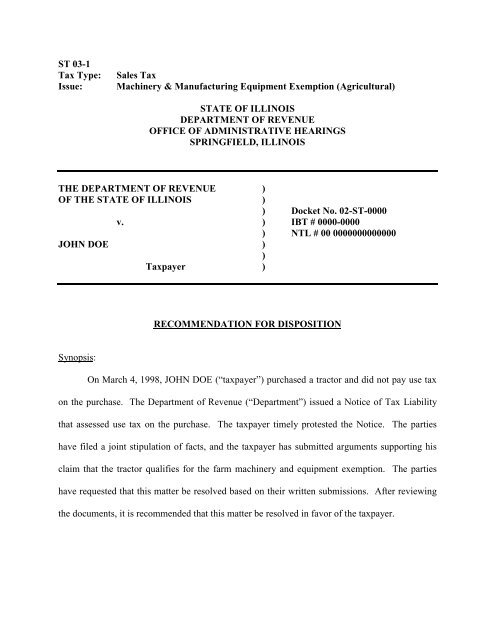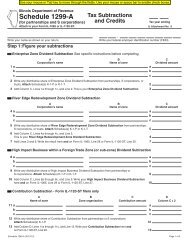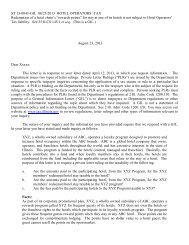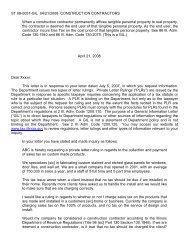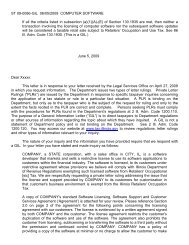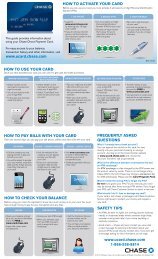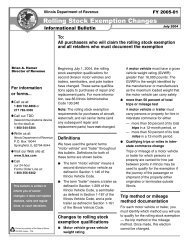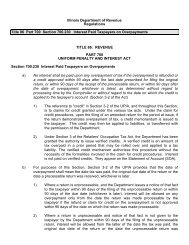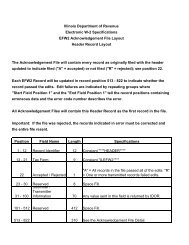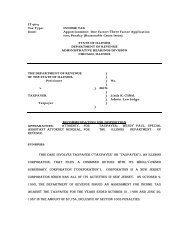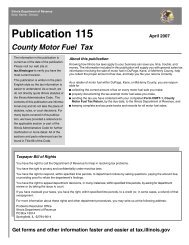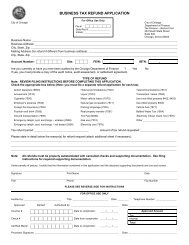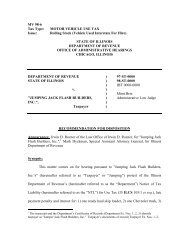Machinery & Manufacturing Equipment Exemption - Illinois ...
Machinery & Manufacturing Equipment Exemption - Illinois ...
Machinery & Manufacturing Equipment Exemption - Illinois ...
Create successful ePaper yourself
Turn your PDF publications into a flip-book with our unique Google optimized e-Paper software.
ST 03-1<br />
Tax Type: Sales Tax<br />
Issue: <strong>Machinery</strong> & <strong>Manufacturing</strong> <strong>Equipment</strong> <strong>Exemption</strong> (Agricultural)<br />
STATE OF ILLINOIS<br />
DEPARTMENT OF REVENUE<br />
OFFICE OF ADMINISTRATIVE HEARINGS<br />
SPRINGFIELD, ILLINOIS<br />
THE DEPARTMENT OF REVENUE )<br />
OF THE STATE OF ILLINOIS )<br />
) Docket No. 02-ST-0000<br />
v. ) IBT # 0000-0000<br />
) NTL # 00 0000000000000<br />
JOHN DOE )<br />
)<br />
Taxpayer )<br />
Synopsis:<br />
RECOMMENDATION FOR DISPOSITION<br />
On March 4, 1998, JOHN DOE (“taxpayer”) purchased a tractor and did not pay use tax<br />
on the purchase. The Department of Revenue (“Department”) issued a Notice of Tax Liability<br />
that assessed use tax on the purchase. The taxpayer timely protested the Notice. The parties<br />
have filed a joint stipulation of facts, and the taxpayer has submitted arguments supporting his<br />
claim that the tractor qualifies for the farm machinery and equipment exemption. The parties<br />
have requested that this matter be resolved based on their written submissions. After reviewing<br />
the documents, it is recommended that this matter be resolved in favor of the taxpayer.
FINDINGS OF FACT:<br />
1. On March 4, 1998, the taxpayer purchased a Caterpillar 955K #0000000 Crawler<br />
tractor for $17,500 from ABC Oil Company of Anywhere, <strong>Illinois</strong>. (Stip. #1)<br />
2. In 1998, the taxpayer purchased approximately 70 acres of land that had previously<br />
been in the Federal Conservation Reserve Program. The taxpayer intended to use half of the<br />
land for corn and hay production and the other half for pasture for cattle and goats. (Joint Ex.<br />
#4)<br />
3. In 1998, the taxpayer used the tractor approximately 50 to 70 hours to control<br />
scattered thorny locust, multiflora rose, and autumn olive from the crop production fields by<br />
tillage. He also used it approximately 50 to 70 hours to clean and reseed grass waterways in the<br />
crop production fields. (Joint Ex. #4)<br />
4. In 1998, the taxpayer used the tractor approximately 75 to 100 hours to repair and stop<br />
leakage in the dam of the livestock watering pond. The pond was leaking through a shale bed at<br />
the corner of the dam, and 150 feet had to be removed and filled in with clay in order to provide<br />
adequate water for the livestock. (Joint Ex. #4)<br />
5. In 1999, the taxpayer used the tractor approximately 40 to 50 hours to pull rolling<br />
cutter in the pasture to control multifora rose and thorny locust. He also used it approximately<br />
40 to 50 hours to repair the fence around the pasture. (Joint Ex. #4)<br />
6. In 1999, the taxpayer used the tractor approximately 15 to 20 hours to level and<br />
prepare the pasture area for seeding. He also used it approximately 10 to 12 hours to load<br />
manure from the livestock loafing area. (Joint Ex. #4)
7. In 2000, he used the tractor approximately 5 to 10 hours to spread limestone in the<br />
wooded pasture used by the cattle. He used it approximately 40 to 50 hours to build an irrigation<br />
water reservoir to provide water for hay production. (Joint Ex. #4)<br />
8. In 2000, the taxpayer used the tractor approximately 10 to 15 hours to pull rolling<br />
cutter to control multiflora rose and thorny locust from the pasture. He used it approximately 5<br />
to 10 hours to carry large bales of hay to the livestock during the winter months. (Joint Ex. #4)<br />
9. In 2001, the taxpayer used the tractor approximately 5 to 10 hours to carry fill dirt<br />
used to level and build up the floor in the cattle loafing shed barn. He also used it approximately<br />
20 to 30 hours to build a fence around the livestock pasture and 5 to 10 hours to pull rolling<br />
cutter to control multiflora rose and thorny locust in the pasture. (Joint Ex. #4)<br />
10. On December 19, 2001, the Department issued a Notice of Tax Liability to the<br />
taxpayer showing use tax in the amount of $1,094 plus interest due on the purchase of the tractor.<br />
(Joint Ex. #8)<br />
CONCLUSIONS OF LAW:<br />
The Use Tax Act (“Act”) (35 ILCS 105/1 et seq.) imposes a tax upon the privilege of<br />
using in <strong>Illinois</strong> tangible personal property purchased at retail from a retailer. 35 ILCS 105/3.<br />
Section 12 of the Act incorporates by reference section 4 of the Retailers' Occupation Tax Act<br />
(35 ILCS 120/1 et seq.), which provides that the Notice of Tax Liability issued by the<br />
Department is prima facie correct and is prima facie evidence of the correctness of the amount of<br />
tax due, as shown therein. 35 ILCS 105/12; 120/4.<br />
Once the Department has established its prima facie case, the burden shifts to the<br />
taxpayer to overcome this presumption of validity. Clark Oil & Refining Corp. v. Johnson, 154<br />
Ill.App.3d 773, 783 (1st Dist. 1987). To prove its case, a taxpayer must present more than its
testimony denying the Department's assessment. Sprague v. Johnson, 195 Ill.App.3d 798, 804<br />
(4th Dist. 1990). The taxpayer must present sufficient documentary evidence to support its claim<br />
for an exemption. Id.<br />
It is well-settled that tax exemption provisions are strictly construed in favor of taxation.<br />
Heller v. Fergus Ford, Inc., 59 Ill.2d 576, 579 (1975). The party claiming the exemption has the<br />
burden of clearly proving that it is entitled to the exemption, and all doubts are resolved in favor<br />
of taxation. Id.<br />
The Department denied the exemption because it believed that the majority of the jobs<br />
performed with the tractor were maintenance activities that do not qualify for the exemption.<br />
The Department did not provide additional arguments in support of its position.<br />
The taxpayer contends that he does not owe use tax on the purchase of the tractor because<br />
it qualifies for the farm machinery and equipment exemption. <strong>Exemption</strong>s from the use tax are<br />
included under section 3-5, which provides in part as follows:<br />
follows:<br />
“Use of the following tangible personal property is exempt from the tax imposed<br />
by this Act:<br />
(11) Farm machinery and equipment, both new and used, including that<br />
manufactured on special order, certified by the purchaser to be used primarily for<br />
production agriculture or State or federal agricultural programs * * *.<br />
Farm machinery and equipment shall include precision farming equipment that is<br />
installed or purchased to be installed on farm machinery and equipment including,<br />
but not limited to, tractors, harvesters, sprayers, planters, seeders, or spreaders. *<br />
* * (35 ILCS 105/3-5(11).)<br />
Section 3-35 of the Act provides a definition of production agriculture and states as<br />
“For purposes of this Act, “production agriculture” means the raising of or the<br />
propagation of livestock; crops for sale for human consumption; crops for<br />
livestock consumption; and production seed stock grown for the propagation of<br />
feed grains and the husbandry of animals or for the purpose of providing a food
product, including the husbandry of blood stock as a main source of providing a<br />
food product. * * *” (35 ILCS 105/3-35.)<br />
Farm machinery and equipment that is used more than 50% of the time for production<br />
agriculture constitutes use “primarily” for production agriculture. (See ST 01-0202 GIL 1 ) The<br />
taxpayer contends that he used his tractor 100% for production agriculture. He says that he did<br />
not use it to maintain the area but to develop the land for the intended use of raising livestock<br />
and field crops.<br />
The facts indicate that the taxpayer used the tractor more than 50% of the time to<br />
cultivate the land in order to prepare it for raising crops and livestock. He used it to till the soil<br />
and to carry dirt to repair the fence, level the pasture area, level the floor in the cattle barn, and<br />
build the dam. He used it to load manure from the livestock area, to spread limestone in wooded<br />
pastures, and to control weed and thorny brush from the crops. He used it to carry large bales of<br />
hay to the livestock and to provide water for the animals and the hay production. The tractor was<br />
never used off the farm premises or for any purpose other than activities related to the farm. The<br />
tractor was primarily used for production agriculture.<br />
Recommendation:<br />
For the foregoing reasons, it is recommended that the tractor qualifies for the farm<br />
machinery and equipment exemption.<br />
Enter: December 30, 2002<br />
_________________________<br />
Linda Olivero<br />
Administrative Law Judge<br />
1 General Information Letter issued by the Department on September 26, 2001.


